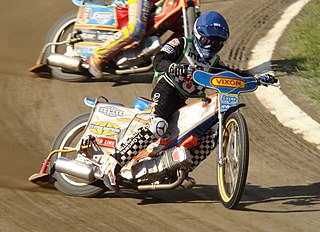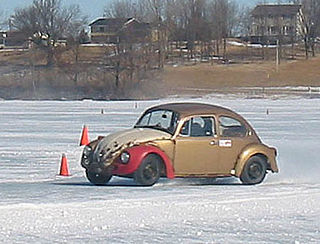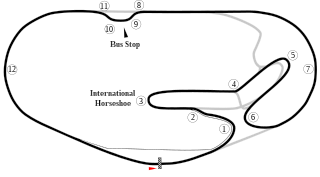Motorcycle sport is a broad field that encompasses all sporting aspects of motorcycling. The disciplines are not all races or timed-speed events, as several disciplines test a competitor's various riding skills.

BMX, an abbreviation for bicycle motocross or bike motocross, is a cycle sport performed on BMX bikes, either in competitive BMX racing or freestyle BMX, or else in general street or off-road recreation.

Grand Prix motorcycle racing is the highest class of motorcycle road racing events held on road circuits sanctioned by the Fédération Internationale de Motocyclisme (FIM). Independent motorcycle racing events have been held since the start of the twentieth century and large national events were often given the title Grand Prix. The foundation of the Fédération Internationale de Motocyclisme as the international governing body for motorcycle sport in 1949 provided the opportunity to coordinate rules and regulations in order that selected events could count towards official World Championships. It is the oldest established motorsport world championship.

Motorcycle speedway, usually referred to simply as speedway, is a motorcycle sport involving four and sometimes up to six riders competing over four anti-clockwise laps of an oval circuit. The motorcycles are specialist machines that use only one gear and have no brakes. Racing takes place on a flat oval track usually consisting of dirt, loosely packed shale, or crushed rock. Competitors use this surface to slide their machines sideways, powersliding or broadsiding into the bends. On the straight sections of the track, the motorcycles reach speeds of up to 70 miles per hour (110 km/h).

Motocross is a form of off-road motorcycle racing held on enclosed off-road circuits. The sport evolved from motorcycle trials competitions held in the United Kingdom.

Supermoto is a form of motorcycle racing held on race tracks that alternate between three kinds of track surfaces: the hard packed dirt of flat track, the irregular jumps and obstacles of motocross, and the paved tarmac of road racing. Supermoto was originally conceived by Gavin Trippe in 1979 as a segment of the TV show Wide World of Sports. It was something like an all-star game, in which the best riders from the three separate genres of motorcycle racing could temporarily leave their normal race class to come together and compete for the title of best all around racer. Today supermoto is a distinct genre of its own and riders in the other classes do not routinely cross over into supermoto.

The Fédération Internationale de Motocyclisme is the global governing/sanctioning body of motorcycle racing. It represents 116 national motorcycle federations that are divided into six regional continental unions.
Cycle sport is competitive physical activity using bicycles. There are several categories of bicycle racing including road bicycle racing, cyclo-cross, mountain bike racing, track cycling, BMX, and cycle speedway. Non-racing cycling sports include artistic cycling, cycle polo, freestyle BMX and mountain bike trials. The Union Cycliste Internationale (UCI) is the world governing body for cycling and international competitive cycling events. The International Human Powered Vehicle Association is the governing body for human-powered vehicles that imposes far fewer restrictions on their design than does the UCI. The UltraMarathon Cycling Association is the governing body for many ultra-distance cycling races.

Ice racing is a form of racing that uses cars, motorcycles, snowmobiles, all-terrain vehicles, or other motorized vehicles. Ice racing takes place on frozen lakes or rivers, or on groomed frozen lots. As cold weather is a requirement for natural ice, it is usually found at higher latitudes in Canada, the northern United States, and in northern Europe, although limited indoor events are held in warmer climates, typically on ice hockey rinks. Tracks in North America vary from 1/4 mile to several mile-long circuits.

Cycle speedway is a form of bicycle racing on short oval dirt tracks, usually outdoors, occasionally indoors, typically 70–90 metres long. Like motorcycle speedway, riders use machines without brakes or multiple gears but, unlike motor speedway, the object is not to slide bikes round the turns.

The Daytona 200 is an annual motorcycle road racing competition held in early spring at the Daytona International Speedway in Daytona Beach, Florida. The 200-mile (320 km) race was founded in 1937 when it was sanctioned by the American Motorcyclist Association (AMA). The original course used the beach itself before moving to a paved closed circuit in 1961. The Daytona 200 reached its zenith of worldwide popularity in the 1970s when the race attracted the largest crowds of any AMA race along with some of the top rated international motorcycle racers.

The British Superbike Championship (BSB), currently known for sponsorship reasons as the Bennetts British Superbike Championship, is the leading road racing superbike championship in the United Kingdom, and is still acknowledged to be the premier domestic superbike racing series in the world.

Motorcycle Grasstrack is a form of track racing which typically, in its current form, takes place on a flat track consisting of two straights and two bends usually constructed in a field. It is one of the oldest types of motorcycle sports in the UK with the first meetings having taken place in the 1920s.

The motorcycle sport of racing includes motorcycle road racing and off-road racing, both either on circuits or open courses, and track racing. Other categories include hill climbs, drag racing and land speed record trials.

Track racing is a form of motorcycle racing where teams or individuals race opponents around an unpaved oval track. There are differing variants, with each variant racing on a different surface type.

Sidecar Speedway is a motorcycle sport involving 4 crews of a rider and a passenger competing over 4 laps on an oval shale surface. Rules are governed by the national speedway federation and are not dissimilar to conventional speedway rules.
Long track is a version of track racing, that takes place on tracks ranging from 425 to 1,000 metres in length at high speeds. There are also subtle differences between longtrack and speedway such as the machinery used in longtrack bike is slightly larger and has a two-speed gearbox. Races usually consist of six riders although occasionally they have eight. Longtrack is very similar with another form of track racing, Grasstrack. The two sports use the same machinery and have a combined World Championship

A motorcycle tyre is the outer part of motorcycle wheel, attached to the rim, providing traction, resisting wear, absorbing surface irregularities, and allowing the motorcycle to turn via countersteering. The two tyres' contact patches are the motorcycle's connection to the ground, and so are fundamental to the motorcycle's suspension behaviour, and critically affect safety, braking, fuel economy, noise, and rider comfort.

Off-road tires are a category of vehicle tires that use deep tread to provide more traction on unpaved surfaces such as loose dirt, mud, sand, or gravel. Compared to ice or snow tires, they lack studs but contain deeper and wider grooves meant to help the tread sink into mud or gravel surfaces.

The following outline is provided as an overview of motorcycles and motorcycling:



















